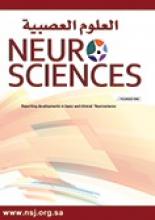Research ArticleOriginal Article
Open Access
Pre-training Catechin gavage prevents memory impairment induced by intracerebroventricular streptozotocin in rats
Marzieh Zamani, Kambiz Rohampour, Maryam Zeraati, Narges Hosseinmardi and Mostafa M. Kazemian
Neurosciences Journal July 2015, 20 (3) 225-229; DOI: https://doi.org/10.17712/nsj.2015.3.20140440
Marzieh Zamani
From the Cellular and Molecular Research Center (Zamani, Rohampour, Kazemian), Qom University of Medical Sciences, Qom, Department of Physiology and Pharmacology (Zeraati), Faculty of Medicine, Alborz University of Medical Sciences, Karaj, and the Department of Physiology (Hosseinmardi), Faculty of Medicine, Shahid Beheshti University of Medical Sciences, Tehran, Iran
MScKambiz Rohampour
From the Cellular and Molecular Research Center (Zamani, Rohampour, Kazemian), Qom University of Medical Sciences, Qom, Department of Physiology and Pharmacology (Zeraati), Faculty of Medicine, Alborz University of Medical Sciences, Karaj, and the Department of Physiology (Hosseinmardi), Faculty of Medicine, Shahid Beheshti University of Medical Sciences, Tehran, Iran
PhDMaryam Zeraati
From the Cellular and Molecular Research Center (Zamani, Rohampour, Kazemian), Qom University of Medical Sciences, Qom, Department of Physiology and Pharmacology (Zeraati), Faculty of Medicine, Alborz University of Medical Sciences, Karaj, and the Department of Physiology (Hosseinmardi), Faculty of Medicine, Shahid Beheshti University of Medical Sciences, Tehran, Iran
PhDNarges Hosseinmardi
From the Cellular and Molecular Research Center (Zamani, Rohampour, Kazemian), Qom University of Medical Sciences, Qom, Department of Physiology and Pharmacology (Zeraati), Faculty of Medicine, Alborz University of Medical Sciences, Karaj, and the Department of Physiology (Hosseinmardi), Faculty of Medicine, Shahid Beheshti University of Medical Sciences, Tehran, Iran
PhDMostafa M. Kazemian
From the Cellular and Molecular Research Center (Zamani, Rohampour, Kazemian), Qom University of Medical Sciences, Qom, Department of Physiology and Pharmacology (Zeraati), Faculty of Medicine, Alborz University of Medical Sciences, Karaj, and the Department of Physiology (Hosseinmardi), Faculty of Medicine, Shahid Beheshti University of Medical Sciences, Tehran, Iran
MSc
References
- ↵
- Weiner MW,
- Veitch DP,
- Aisen PS,
- Beckett LA,
- Cairns NJ,
- Green RC,
- et al.
- ↵
- Mayeux R
- ↵
- Braak H,
- Braak E,
- Bohl J,
- Bratzke H
- ↵
- Butterfield DA,
- Reed T,
- Newman SF,
- Sultana R
- ↵
- Zhu X,
- Lee HG,
- Perry G,
- Smith MA
- ↵
- Nunomura A,
- Perry G,
- Aliev G,
- Hirai K,
- Takeda A,
- Balraj EK,
- et al.
- ↵
- Nunomura A,
- Perry G,
- Pappolla MA,
- Friedland RP,
- Hirai K,
- Chiba S,
- et al.
- ↵
- Praticò D,
- Uryu K,
- Leight S,
- Trojanoswki JQ,
- Lee VM
- ↵
- Smith MA,
- Hirai K,
- Hsiao K,
- Pappolla MA,
- Harris PL,
- Siedlak SL,
- et al.
- ↵
- Hayashi T,
- Shishido N,
- Nakayama K,
- Nunomura A,
- Smith MA,
- Perry G,
- et al.
- ↵
- Ye X,
- Tai W,
- Zhang D
- ↵
- Wang X,
- Su B,
- Siedlak SL,
- Moreira PI,
- Fujioka H,
- Wang Y,
- et al.
- ↵
- Lee HG,
- Casadesus G,
- Zhu X,
- Takeda A,
- Perry G,
- Smith MA
- ↵
- Weinreb O,
- Mandel S,
- Amit T,
- Youdim MB
- ↵
- Nanjo F,
- Goto K,
- Seto R,
- Suzuki M,
- Sakai M,
- Hara Y
- ↵
- Pan MH,
- Lin-Shiau SY,
- Ho CT,
- Lin JH,
- Lin JK
- ↵
- Nobre Júnior HV,
- Cunha GM,
- Maia FD,
- Oliveira RA,
- Moraes MO,
- Rao VS
- ↵
- Levites Y,
- Amit T,
- Mandel S,
- Youdim MB
- ↵
- Levites Y,
- Weinreb O,
- Maor G,
- Youdim MB,
- Mandel S
- ↵
- Levites Y,
- Youdim MB,
- Maor G,
- Mandel S
- ↵
- Behl C,
- Davis J,
- Cole GM,
- Schubert D
- ↵
- Choi DY,
- Lee YJ,
- Hong JT,
- Lee HJ
- ↵
- Paxinos G,
- Watson C
- ↵
- Parvez S,
- Tabassum H,
- Rehman H,
- Banerjee BD,
- Athar M,
- Raisuddin S
- ↵
- Babri S,
- Badie HG,
- Khamenei S,
- Seyedlar MO
- ↵
- Hoyer S
- ↵
- Lannert H,
- Hoyer S
- ↵
- Agrawal R,
- Tyagi E,
- Shukla R,
- Nath C
- ↵
- Ho L,
- Qin W,
- Pompl PN,
- Xiang Z,
- Wang J,
- Zhao Z,
- et al.
- ↵
- Cheng CM,
- Tseng V,
- Wang J,
- Wang D,
- Matyakhina L,
- Bondy CA
- ↵
- Li Q,
- Zhao HF,
- Zhang ZF,
- Liu ZG,
- Pei XR,
- Wang JB,
- et al.
- ↵
- Butterfield DA,
- Boyd-Kimball D
- ↵
- Watanabe H,
- Kobayashi A,
- Yamamoto T,
- Suzuki S,
- Hayashi H,
- Yamazaki N
- ↵
- Zhang L,
- Zhao B,
- Yew DT,
- Kusiak JW,
- Roth GS
- ↵
- Cuevas E,
- Limón D,
- Pérez-Severiano F,
- Díaz A,
- Ortega L,
- Zenteno E,
- et al.
- ↵
- Tournaire C,
- Croux S,
- Maurette MT,
- Beck I,
- Hocquaux M,
- Braun AM,
- et al.
- ↵
- Khan SG,
- Katiyar SK,
- Agarwal R,
- Mukhtar H
- ↵
- Kimura M,
- Umegaki K,
- Kasuya Y,
- Sugisawa A,
- Higuchi M
In this issue
Pre-training Catechin gavage prevents memory impairment induced by intracerebroventricular streptozotocin in rats
Marzieh Zamani, Kambiz Rohampour, Maryam Zeraati, Narges Hosseinmardi, Mostafa M. Kazemian
Neurosciences Journal Jul 2015, 20 (3) 225-229; DOI: 10.17712/nsj.2015.3.20140440
Jump to section
Related Articles
- No related articles found.
Cited By...
- No citing articles found.





